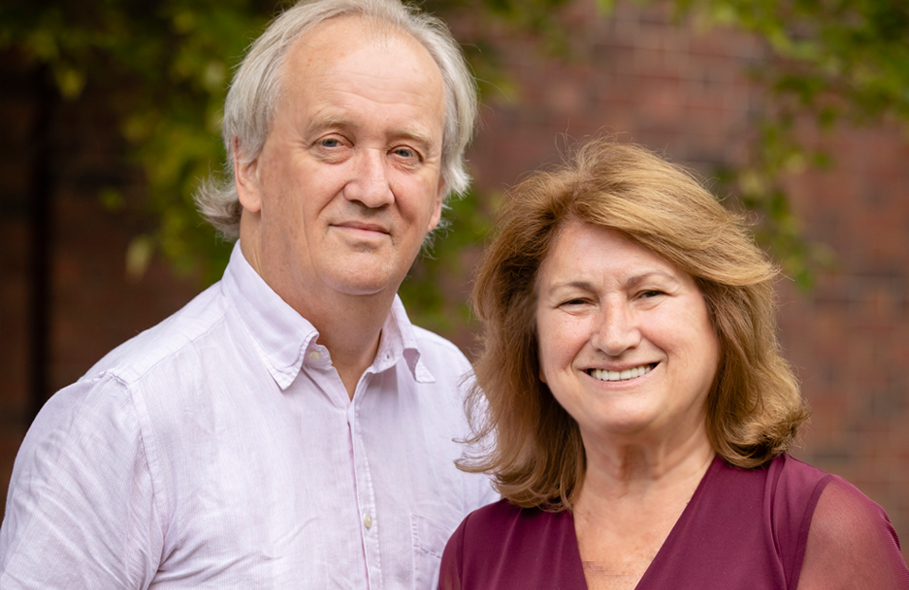Professors Developing Technologies That Could Revolutionize the Medical Field
by Tom Hanlon / Apr 9, 2021

Two College of Education professors are creating learning analytics tools to enhance medical students’ education and clinical critical thinking skills.
Drs. Bill Cope and Mary Kalantzis, professors in the Department of Education Policy, Organization and Leadership, are involved in two interdisciplinary projects funded through the Jump ARCHES research and development program. Jump ARCHES—Jump Applied Research through Community Health through Engineering and Simulation—is a partnership between the University of Illinois Urbana-Champaign, the University of Illinois College of Medicine Peoria, and OSF HealthCare in Peoria. The program was established in 2014 and supports research involving clinicians, engineers, and social scientists to develop technologies and devices that could revolutionize medical training and healthcare delivery.
In January 2021, 13 research projects received new funding through Jump ARCHES. Cope and Kalantzis are involved in two of them. Cope is principal investigator and Kalantzis a team member for both MedLang Phase II: An Intelligent Medical Record, and MedLang Phase IL: A Concept-Mapping Tool for Case Analysis. Other participants in the project include Dr. Richard Tapping and Dr. Yerko Berrocal in the University of Illinois College of Medicine at Peoria; Dr. ChengXiang Zhai in the College of Engineering at Illinois; Dr. Duncan Ferguson, Emeritus Professor of Veterinary Medicine at Illinois; and software development and artificial intelligence researcher, Duane Searsmith.
Here, Cope talks about their work on the Jump ARCHES projects.
Tell me how the Concept-Mapping Tool for Case Analysis project came about.
This project began in 2015 with the Illinois Learning Sciences Design Initiative, led by Professor Fouad Abd-El-Khalick when he was associate dean for research and research education and director of the Bureau of Educational Research. This was a seed project in which we used the CGScholar eLearning platform in the College of Medicine and the College of Veterinary Medicine for clinical case analysis.
What happened from there?
The seed took root, and has led to a series of follow-on projects, including an NSF project, “Assessing Complex Epistemic Performance in Online Learning Environments,” the Jump ARCHES “MedLang” project, and a project funded by the dean of the College of Medicine in Peoria on team-based communication. And noew these two new Jump ARCHES projects.
Tell me about the NSF project.
In the NSF project, students developed clinical case analyses of persons (trialing in the College of Medicine) or animals (in the College of Veterinary Medicine), and peer-reviewed each other’s analyses. Our aim was to nurture what the team termed “critical clinical thinking.” Medical education tends to involve a great deal of content delivery in lectures and textual material, measured by what is essentially factual recall in item-based tests. But clinical questions often don’t have straightforward ABCD answers. Being a doctor involves professional judgment, backed up by evidence-based argument, and dialogues in a medical team context.
What was the outcome of this project?
The main outcome was to create a learning analytics tool that tracks learner progress based on these higher-level thinking objectives and represents these on a number of dimensions in an aster plot visualization.
What is the purpose of the MedLang project?
The MedLang project created a tool for this environment in which students can call up medical concepts and create a concept map visualization that overlays their clinical analysis. In the first phase of this project, we created a prototype and demonstrated its feasibility.
And now MedLang has received new funding, and is in a second phase?
This new funding takes the MedLang tool to a new stage. In this phase, we will trial the tool in a number of classes, including the classes of medical educators who are working on our online Learning Design and Leadership doctorate. We will use agile programming methods to refine the tool as the project unfolds.
What stage is the project in now?
We are just beginning this project.
What is the hoped-for outcome for this project?
This is an ambitious extension of the MedLang projects, applying the experience we have gained in MedLang in the areas of machine learning and artificial intelligence. With the electronic health record project, we are extending this work into the wider domain of medical informatics. For the purposes of our prototype development in this project, we will use open-source medical record software. MedLang will draw upon the standardized medical schemas used in electronic health record and insurance systems, supporting medical practitioners with suggestions offering a mapping tool with which to conceptualize a case.